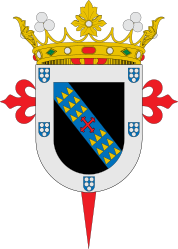Juan de Acuña, 1st Marquess of Casa Fuerte facts for kids
Quick facts for kids
The Most Excellent
The Marquess of Casa Fuerte
|
|
|---|---|

Portrait by Juan Rodríguez Juárez
|
|
| 37th Viceroy of New Spain | |
| In office October 15, 1722 – March 17, 1734 |
|
| Monarch | Philip V |
| Preceded by | Baltasar de Zúñiga |
| Succeeded by | Juan Antonio de Vizarrón |
| Personal details | |
| Born | February 22, 1658 Lima, Peru |
| Died | March 17, 1734 (aged 76) Mexico City, New Spain |
Juan de Acuña y Bejarano, 1st Marquess of Casa Fuerte (Spanish: Juan de Acuña y Bejarano, primer Marqués de Casa Fuerte) was an important Spanish leader. He was born on February 22, 1658, and passed away on March 17, 1734. He served as the viceroy of New Spain, which was a large Spanish colony in North America.
Contents
Early Life and Military Career
Juan de Acuña was special because he was a Criollo. This means he was Spanish, but he was born in the "New World" (the Americas). He was born in Lima, which is now the capital of Peru, in 1658.
From a young age, Juan de Acuña joined the military. He was very good at his job and moved up quickly. He started as a captain and became a general in charge of artillery. He also served as governor of Messina in Sicily. He was even made a knight of the military Order of Santiago, which was a great honor. Before becoming viceroy, he was a military commander in Aragon and Mallorca in Spain.
Leading New Spain as Viceroy
Juan de Acuña arrived in Mexico City and officially became the viceroy on October 15, 1722. People in New Spain really liked him. They liked that he was a Criollo, like many of them. He also chose his helpers based on their skills, not just their family connections.
Improving the Colony's Money
When he started, the government's treasury was almost empty. There was a lot of public debt. So, he focused on improving the colony's money situation. He managed to increase the money coming into the government by about one million pesos each year. This brought the total to eight million pesos annually.
Peace and Progress
He brought peace to the Nayar region by sending a military group there. They also set up new settlements. He started a factory in Orizaba to make cannons. These cannons helped protect the ports and coasts. He also improved the mines in Pachuca, which helped them get more valuable metals.
Dealing with English Traders
The English were cutting down valuable wood in Yucatan and Belize. A Spanish ship captured some English ships carrying this wood. Juan de Acuña sent a small fleet of ships and 300 men to stop the English. However, the English had many more men and large warships. So, the Spanish effort was not successful. Talks between the two countries also didn't solve the problem. The viceroy decided to focus on things he could control, like strengthening the forts at San Juan de Ulúa and Veracruz.
New Buildings and Laws
In 1728, he allowed the newspaper La Gaceta de México to start publishing again. It had stopped in 1722. In 1730, he ordered all silversmiths to move their shops to one central street. In 1731, he ordered the building of a new customshouse and warehouses. He also had the mint rebuilt. The mint was famous for making high-quality coins. In 1730, it produced over ten million pesos in silver and a lot of gold coins.
Extended Term and New Settlements
Because he was honest and governed well, his term as viceroy was extended for three more years in 1727. In 1731, sixteen families from the Canary Islands arrived in Texas. They founded a town called La Villa de San Fernando. This was the first civil government in Texas. The viceroy gave these families special titles. Many of their descendants still live in San Antonio today.
Limiting the Inquisition
He also put strong limits on the Inquisition. This was a powerful religious court. He believed their actions were sometimes unfair.
Religious and Cultural Contributions
The pope ordered the building of the Colegiata de Nuestra Señora de Guadalupe after the viceroy asked for it. In 1730, a beautiful screen for the choir was put in the cathedral. It was made in Macau and brought to New Spain by a ship from China.
Juan de Acuña y Manrique passed away in Mexico City on March 17, 1734. He was buried in the church of San Cosme y San Damián.
Arms
- Heraldry of Juan de Acuña, 1st Marquess of Casa Fuerte
See also
 In Spanish: Juan Vázquez de Acuña y Bejarano para niños
In Spanish: Juan Vázquez de Acuña y Bejarano para niños


